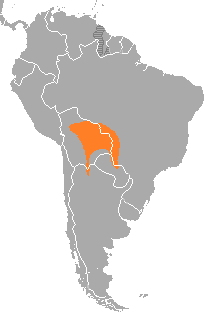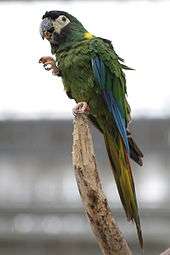Golden-collared macaw
| Golden-collared macaw | |
|---|---|
 | |
| Scientific classification | |
| Kingdom: | Animalia |
| Phylum: | Chordata |
| Class: | Aves |
| Order: | [Psittaciformes]] |
| Family: | Psittacidae |
| Genus: | Primolius |
| Species: | P. auricollis |
| Binomial name | |
| Primolius auricollis (Cassin, 1853) | |
 | |
The golden-collared macaw or yellow-collared macaw (Primolius auricollis) is a small mostly green Central South American parrot, a member of a large group of Neotropical parrots known as macaws. It has a bright yellow patch on the back of its neck/upper shoulders that gives the species its name. In aviculture, it is one of a number of smaller macaws often called "mini-macaws".
Taxonomy
The golden-collared macaw was described by American ornithologist John Cassin in 1853. Its specific epithet auricollis meaning gold-collared, from the Latin aurum 'gold', and collum 'neck'.[2] In recent years it has often been placed in the genus Propyrrhura, but this is incorrect as per ICZN rules. Earlier, it had also been placed in the genus Ara.
Description


It has a total length of about 38 cm (15 in), of which almost half is tail feathers. The general plumage is green, with a distinct yellow collar that is broadest on the back of the neck. The yellow collar develops as the bird ages, with more vibrant colors found in mature birds. The front and crown is brownish black. The remiges and primary coverts are blue and the long, pointed tail has a red base, a narrow green center and a blue tip. The underside of the tail and flight feathers are greenish-yellow, similar to that of several other small macaws such as the blue-winged and red-bellied macaw. The legs are a dull pinkish color, and the iris is reddish to dull yellow. It has extensive bare white facial skin and the heavy bill is black, often tipped pale grey.
Distribution and habitat
The main population occurs in the Pantanal of Brazil (south-western Mato Grosso, western Mato Grosso do Sul and southern Rondônia), northern Argentina (eastern Jujuy and northern Salta), far northern Paraguay (Alto Paraguay and Concepción) and most of northern and eastern Bolivia (Beni, Santa Cruz, Chuquisaca and Tarija). A second disjunct population occurs in far north-eastern Mato Grosso, south-eastern Pará and western Tocantins in Brazil.
It occurs in forest (but avoids the Amazon Rainforest), woodland, savanna and grassland with scattered trees. It mainly occurs in lowlands, but locally up to an altitude of 1,700 m (5,600 ft).
Conservation status
It is generally fairly common and therefore considered to be of least concern by BirdLife International. The species is listed in CITES Appendix II, which means that commercial trade is allowed with an export permit (plus an import permit if required by laws of the importer's country).
Behavior
Typically seen in pairs or, during non-breeding season, small flocks.
Domestic Pet Behavior
As a domestic pet a yellow collared is extremely social and demands attention. It requires about three to four hours per day of interaction or he will start to squawk, which can be loud enough to be heard from outside the house. When properly cared for they can live up to fifty years. This little bird can rest on your shoulder for hours at a time and at times will require cuddling. They are also very curious and love to chew, and love to hang about you just for fun.
Temperament
Affectionate, and somewhat mischievous, the Yellow Collared Macaw has a reputation for being an intelligent and resourceful little parrot. They thrive on attention from their owners, and like other Macaws, will seek that attention by any means necessary. They also require a large cage with many toys because they get bored easily. Many Yellow Collared Macaws are little escape artists, so steps should be taken to provide a cage that is safe and secure. Although some are one-person birds, most Yellow Collared Macaws make extraordinary family pets. They also can have a pretty extensive vocabulary and when given attention he will bond with you and protect you. They can be clowns and very affectionate but unpredictable where it will be cuddling with you one minute and trying to bite you the next. This bird will make you laugh and loves to play rough. This bird is not recommended for those who are not at home as it has been known to get aggressive without attention. Caution should be taken with little children.
Feeding
Feeds on fruits, flower buds and seeds. In captivity they will try anything even chicken (although not recommended). For those who have these for pets they require veggies, fruits, and nuts. Avocado is poisonous for them and beware of chocolate.
Breeding
The golden-collared macaw nest in a hole in a tree. The eggs are white and there are usually two or three in a clutch. The female incubates the eggs for about 26 days, and the chicks fledge from the nest about 70 days after hatching.[3]
See also
References
- ↑ BirdLife International (2012). "Primolius auricollis". IUCN Red List of Threatened Species. Version 2013.2. International Union for Conservation of Nature. Retrieved 26 November 2013.
- ↑ Simpson DP (1979). Cassell's Latin Dictionary (5th ed.). London: Cassell Ltd. p. 883. ISBN 0-304-52257-0.
- ↑ Alderton, David (2003). The Ultimate Encyclopedia of Caged and Aviary Birds. London, England: Hermes House. p. 236. ISBN 1-84309-164-X.
- Juniper, T. & Parr, M. (1998). A Guide to the Parrots of the World. Pica Press, East Sussex. ISBN 1-873403-40-2
- To reassign the genus of three macaws South American Classification Committee.
External links
- "Yellow-collared macaw media". Internet Bird Collection.
- Stamps (for Argentina, Bolivia) with RangeMap
- Golden-collared macaw photo gallery VIREO
- Yellow-collared macaw at Cornell's NeotropicalBirds
